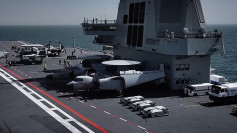The U.S. Air Force will begin production of the country's first air-launched hypersonic missile in 2021, five years earlier than expected, and will deploy it against China after 2022.
The AGM-183A ARRW (Air-Launched Rapid Response Weapon) is a boost glide weapon with a high-explosive warhead propelled to a maximum speed of Mach 20 (24,700 km/h) by a missile. The glide weapon detaches from the missile and hurtles towards its target with a speed exceeding Mach 5 (6,100 km/h).
The preferred launch platforms for this weapon are the Rockwell B-1B Lancer supersonic strategic bomber, which can carry up to 31 ARRWs, and the Boeing B-52G Superfortress. The missile's modest length of some 10 feet, however, will allow the ARRW to be deployed by a McDonnell Douglas F-15 Eagle.
Dr. Will Roper, Assistant Secretary of the Air Force for Acquisition, Technology and Logistics, said production of the ARRW will follow a final flight test later this month. ARRW completed captive-carry tests on B-52 heavy bombers earlier this year. The ARRW program passed its critical design review last week.
"As we field the first hypersonic weapon, and I'm excited we're doing that, it doesn't undercut this investment our adversaries have, nor take away the principle of safety that I would expect they hold," according to Roper.
"The U.S. has exceptional capabilities, especially in stealth aircraft that can penetrate and put weapons where they wish. So do our adversaries believe we don't have the ability to target them? I would hope not. Hypersonic weapons just then become another way to do it."
Roper noted that hypersonic capabilities give the Air Force a valuable stand-off strike option especially useful against China.
Stealth jets such as the Lockheed Martin F-35 Joint Strike Fighter and stealth missiles give the U.S. a strategic advantage in penetrating air defenses. A hypersonic capability enables more vulnerable aircraft such as B-52 bombers to stand-off at a distance while attacking well-defended targets.
This combination presents China with "a landscape of problems," said Roper.
Gen. Duke Z. Richardson, Military Deputy, Office of the Assistant Secretary of the Air Force for Acquisition, Technology, and Logistics, earlier said ARRW was developed using rapid prototyping. This means ARRW will receive operational capability by 2022, or five years earlier than if it was developed under a traditional program.
He said moving faster in weapons development is critical to making the Air Force ready and able to defeat adversaries of the United States.
ARRW was selected over the Hypersonic Conventional Strike Weapon because it's more advanced and is a better match to the Air Force's needs.
"The reason we went with ARRW was not that HCSW was bad, but ARRW is smaller; we can carry twice as many on the B-52, and it's possible it could be on the F-15 ... It's in the class to be able to fit on the centerline" station, said Roper.
He called ARRW a "unique design" and "more advanced" than HCSW.






